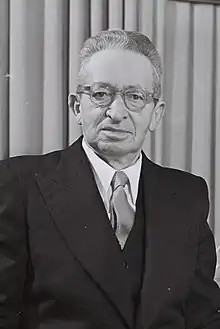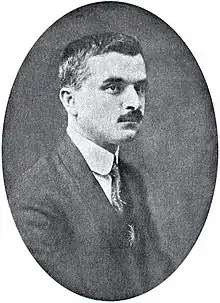Galatasaray High School
Galatasaray High School (Turkish: Galatasaray Lisesi, French: Lycée de Galatasaray) is a high school in Turkey. Established in 1481, it is the oldest high school in Turkey and the second-oldest Turkish educational institution after Istanbul University, which was established in 1453. Being an Anatolian High School, access to the school is open to students with a high nationwide high school entrance score. Education consists of a blend of Turkish and French curricula and is provided in both languages.
| Galatasaray High School Lycée de Galatasaray Galatasaray Lisesi | |
|---|---|
 Galatasaray High School | |
| Address | |
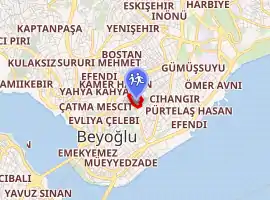
| |
Galatasaray Square Galatasaray , | |
| Coordinates | 41°01′58″N 28°58′43″E |
| Information | |
| School type | Public, Boarding |
| Founded | 1481 |
| Founder | Bayezid II |
| Principal | Vahdettin Engin |
| Color(s) | Red and yellow |
| Mascot | Lion |
| Website | www.gsl.gsu.edu.tr |
The association football club Galatasaray S.K. was formed by and named after the institution. The footballers consisted entirely of students of the school during the club's formative years. Galatasaray High School is the progenitor of Galatasaray Community, which includes the football club, its parent Galatasaray Sports Club, and Galatasaray University.
The name Galatasaray means Galata Palace, as the school is located close to northern end of Galata, the medieval Genoese citadel at the north of the Golden Horn, in the district of Beyoğlu which includes the Galata quarter.
History
The history of Galatasaray High School dates back to 1481. The high school was first built in Pera (Beyoğlu) and called Galata Sarayı Enderun-u Hümayunu (Galata Palace Imperial School).
Origins (1481–1830)
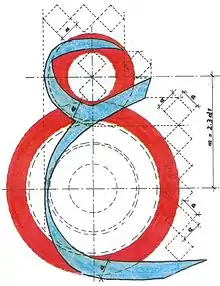
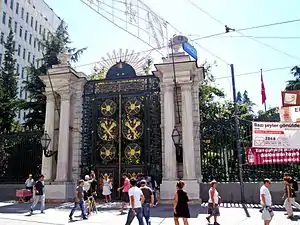

Bayezid II (1447–1512) founded the Galata Sarayı Enderun-u Hümayunu in 1481. Known as the "peaceful Sultan", he revived the city of Constantinople (as Istanbul was known in English at the time and until 1930) after the conquest of 1453. Bayezid II often roamed the city, disguised as an ordinary citizen. Legend has it that on one of these rambles, he found a garden near Galata filled with beautiful red and yellow roses. In this garden, he met Gül Baba (Father Rose) of the Bektashi Order. The Sultan asked the wise man about how to improve the Empire and the city as they filled with a range of immigrants. Gül Baba explained that he was happy with the city, his rose garden and the reign of the Sultan, but he would be much happier if there were a school which would educate all students from this diverse range of backgrounds, as this would train the wise men needed to serve such a large Empire. He told the Sultan he would be proud to serve as a teacher in this school in order to create a generation of valuable subjects to the Empire. Bayezid II took Gül Baba at his word and returned to the garden weeks later with the edict which established the Ottoman Imperial School, on the grounds next to the rose garden, with Gül Baba as its headmaster. Gül Baba became the first headmaster of Galatasaray and administered the school for many years. He died during the Ottoman raid to Hungary and his tomb is located in Budapest.
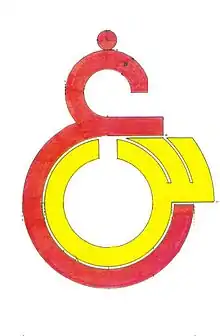
When the Ottoman army went to war, dervishes and minstrels accompanied it to provide religious prayers and entertainment. Dervishes and minstrels also armed themselves and joined the fighting whenever necessary. Gül Baba was one of these dervishes. Janissaries were fond of the dervishes of the Bektashi Order, since they regarded Haji Bektash as their convent's chief.
Interim period (1830–1868)
Galata Palace Imperial School remained open until the 1830s, when the movement of reform and reorganization abolished the Ottoman Empire's old establishment. Sultan Mahmud II (1808–1839) replaced the Imperial School with the Ottoman Medical School, staffed largely by French professors with most courses taught in French. The Medical School was based at the Galata Palace buildings for some thirty years.
Modern period (1868–1923)
Sultan Abdülaziz (1861–1876) was the first Ottoman sultan to travel to Europe. Invited by Napoleon III, in June–July 1867 he attended the World Exhibition in Paris. He then visited Queen Victoria in London, Wilhelm I in Prussia and Franz Joseph I in Vienna. Sultan Abdülaziz was impressed by the French educational system during his visit, and on his return to Constantinople, he announced the Edict of Public Education which established a free compulsory education system for all children until they became twelve. In September 1868, influenced by the French Lycée model, a school was established under the name "Lycée Impérial Ottoman de Galata-Sérai" (Galatasaray Mekteb-i Sultanisi). French was the main language of instruction, and many teachers were European. The students included members of all religious and ethnic communities of the Ottoman Empire. The Ottoman Turkish name was "The Imperial School" or Mekteb-i Sulṭānī.[1]
In the early portion of the modern period, beginning in 1868 and until 1878, most of the students were of religions other than Islam. At the time many of the students were Bulgarian.[2]
Since this period, the district where this institution stands has been known as Galatasaray. In 1905, in one of Galatasaray's classrooms (Literature 5B), the Galatasaray Sports Club was founded by Ali Sami Yen and his friends.
Establishment of the Republic of Turkey to Integrated Education System (1923–1992)
With the abolition of the Ottoman Empire and the proclamation of the Republic of Turkey in 1923, the name of the school was changed to "Galatasaray Lisesi" (Lycée de Galatasaray).
Atatürk, the founder of modern Turkey, visited Galatasaray 3 times: on December 2, 1930; January 28, 1932; and July 1, 1933.
Instruction was conducted in Turkish and French, and the school was composed of an Elementary School (5 years) and a Lycée (7 years) where French Language and Literature, Philosophy, Mathematics, Physics, Chemistry, English, and German were taught selectively in the last four years.
The school became co-educational in 1965, and female students now constitute at least 40% of the school's pupils.
One of the main buildings of the Feriye Palace on the Bosphorus, in the Ortaköy district, was also given to Galatasaray when it needed more room for expansion.
Integrated Education System (1992–present)
In the 1990s, Galatasaray entered another period of transformation. The signing of the Turkish-French Bilateral Agreement of 1992 led to the foundation of Galatasaray University which essentially grew out of the Lycée. With the addition of a new primary education school, the three units emerged as autonomous components of an integrated education system under the aegis of the University.
Admission to the High School (or Lycée) is by selective examinations. T Galatasaray admits about one hundred children a year. Many graduates of the High School continue their education at Galatasaray University, where 25 percent of the enrollment quota is reserved for them.
Until 1997, the high school, or Lycée de Galatasaray, was an 8-year school. After children had completed the 5-year compulsory primary school course, they then had two years of preparatory, three years of junior high, and three years of senior high school education. In the 2003–2004 academic year Galatasaray became a 5-year senior high school, with the introduction of the 8-year compulsory primary education system in Turkey, including one year prep.
Galatasaray, being a boarding school, has a diverse student body, with boys and girls coming from every part of the country. The current curriculum consists of a blend of Turkish and French curricula, plus a number of additional language courses and elective subjects. Courses on Turkish literature, geography, history, ethics, and art are taught in Turkish, while French Literature, philosophy, sociology, mathematics, and science courses use French as the language of instruction. In addition, English is taught in the primary schools from the sixth grade and up, while Italian and Latin are taught in the high school grades.
The students set up an English Club in 1997, which regularly participates in the Harvard Model United Nations Conferences and European Youth Parliament's International Sessions and other events throughout the year.
The Lycée de Galatasaray diploma is equivalent to the French Baccalaureate, and graduates of Galatasaray are admitted to universities in France without further examinations.
Education
Education is primarily in French and Turkish. English and Italian are also taught as second languages. There is also a slight exposure to Ottoman Turkish, Persian, and Arabic through literature and religion classes, as well as Latin and Greek through French classes. Students who gain admission to Galatasaray High School through the national examination rank in the top 500 students among approximately a million pupils.
The school years break down as follows:
French Prep (1 year) Lyceum (4 years) — admission through the Secondary Education Institutions Entrance Exam (OKS) French Prep (1 year) University (4 years) — admission through the National University Entrance Exam (OSS)
In 2003, an eight-year primary school system (which integrated the previous five years of elementary school and three years of junior high under a single body) was added in. With this new system, the one year prep and four-year junior high education were transitioned into the primary school.
 GS High School in winter
GS High School in winter Galatasaray High School Main Entrance
Galatasaray High School Main Entrance Galatasaray Museum
Galatasaray Museum
Galatasaray sports
Galatasaray extracurricular activities
- GSL Biology Club
- GSL Mathematics Club
- GSL Rugby Club
- GSL Music Club
- GSL Press Club
- GSL Culture and Literature Club
- GSL Theatre Club
- GSL Arts Club
- GSL Social Sciences Society
- GSL Folklore Club
- GSL French Club
- GSL Travel Club
- GSL Gastronomy Club
- GSL Sports Club
- GSL Science & Technology Club
- GSL Photography Club
- GSL Tango Club
- GSL Civil Protection Club
- GSL Cinema Club
- GSL Natural Sports Club
- GSL Philosophy Club
- GSL Permaculture Club
- GSL Animal Welfare and Ecology Club
- GSL Computer Club
- GSL Robotics Club
- GSL Historical Simulation Club
- GSL Chess Club
- GSL English Club
- GSL Anime-Manga Club
- GSL Board Games Club
Notable alumni
Grand viziers and prime ministers
- Çorlulu Ali Paşa, Grand Vizier of the Ottoman Empire
- Melek Ahmet Paşa, Grand Vizier of the Ottoman Empire
- Suat Hayri Ürgüplü, Prime Minister of Turkey
- Nihat Erim, Prime Minister of Turkey
Foreign kings, presidents and prime ministers
- King Zog of Albania (1928–1939)
- Yitzhak Ben-Zvi (1884–1963), historian, Labor Zionist leader, and 2nd President of Israel
- Mohammed Ali Bey al-Abed, President of Syria (1932) and Ambassador of Syria to the United States in Washington D.C. (1890 graduate)
- Suphi Bereket, Prime Minister of Syria
Ministers
- Mehmet Sait Paşa, Vizier of the Ottoman Empire
- Abdurrahman Abdi Paşa, Vizier of the Ottoman Empire
- Mahmut Muhtar Paşa, Minister of Navy of the Ottoman Empire (1886 graduate)
- Keçecizade Fuat Paşa, Minister of Foreign Affairs of the Ottoman Empire
- Selim Melhame Paşa, Minister of Agriculture of the Ottoman Empire (1895-1908)
- Abdurrahman Şeref, Minister of Education of the Ottoman Empire
- Osman Nizami Paşa, Minister of Construction of the Ottoman Empire (1876 graduate)
- Şemsettin Paşa, Minister of Documents of the Ottoman Empire (1878 graduate)
- Mustafa Reşit Paşa, Minister of the Ottoman Empire between 1912 and 1920
- Ali Paşa
- Dr. Cemil Topuzlu, Minister of Construction of the Ottoman Empire
- Sabahattin Tanman, Minister of Customs and Monopoly of the Ottoman Empire
- Prof. Yusuf Hikmet Bayur, Minister of Education of the Ottoman Empire (1908 graduate) - Was a Galatsaray teacher in 1912-1920[3]
- Necmeddin Sadak, Minister of Foreign Affairs (1910 graduate)
- İ. Hakkı Baban, Minister of Education
- Hamdullah Suphi Tanrıöver, Minister of Education
- Şükrü Kaya, Minister of Agriculture, Interior and Foreign Affairs
- Hikmet Bayur, Minister of Education
- Feridun Cemal Erkin, Minister of Foreign Affairs
- Suat Hayri Ürgüplü, Minister of Customs and Monopoly
- Fatin Rüştü Zorlu, Minister of Foreign Affairs
- Kasım Gülek, Minister of Construction, Transport and State
- Cihad Baban, Minister of Culture and Tourism
- Prof. Dr. Nihat Erim, Minister of Construction, Deputy Prime Minister
- Turan Güneş, Minister of Foreign Affairs
- Orhan Eyüpoğlu, Minister of State
- Prof. Dr. Orhan Dikmen, Minister of Agriculture
- Malik Yolaç, Minister of Youth and Sports
- Necmettin Cevheri, Minister of State
- İlter Türkmen, Minister of Foreign Affairs
- Prof. Dr. Turhan Feyzioğlu, Deputy Prime Minister
- Şahap Kocatopçu, Minister of Industry and Trade
- Hasan Esat Işık, Minister of State, Minister of Foreign Affairs
- Dr. Ali Tanrıyar, Minister of Interior
- Mükerrem Taşçıoğlu, Minister of Culture and Tourism
- Coşkun Kırca, Minister of Foreign Affairs
- İlhan Evliyaoğlu, Minister of Culture and Tourism
- Prof. Dr. Mümtaz Soysal, Minister of Foreign Affairs
- Fikri Sağlar, Minister of Culture
Ministers of foreign countries
- Konstantin Velichkov, Minister of Education of Bulgaria and writer (1874 graduate)
Governors
- Serasker Mehmet Sait Paşa
- Mar'i Pasha Al Mallah, last Ottoman Interim Governor of the Province of Aleppo, Syria (1876 graduate)
Notable diplomats
Below are the names of Galatasaray alumni, who represented the Republic of Turkey as ambassadors to the United States, Canada, the United Nations and other countries.
United States:
- Feridun Cemal Erkin (GS. 1920) 1948–1955
- Şükrü Elekdağ (GS. 1943) 1979–1989
- Melih Esenbel 1960, 1967-1974, 1975-1979
- Suat Hayri Ürgüplü (GS. 1924) 1957–1960
Canada:
- Coşkun Kırca (GS. 1945) 1985–1986
United Nations:
- Coşkun Kırca (GS. 1945) 1980–1985
- İlter Türkmen (GS. 1945) 1975–1980 and 1985–1988
Austria:
- Daniş Tunalıgil (GS. 1933) –1975
France
- Necdet Kent: Given the title Righteous among the Nations for saving many Jews in the invaded city of Marseille in World War II.
Famous writers and poets
Other notable alumni
- Yunus Nadi Abalıoğlu, journalist
- Daron Acemoglu, economist
- Ali Sami Yen, founder of the Galatasaray S.K.
- Engin Ardıç, journalist
- Bülent Arel, composer
- Ünal Aysal, 34th president of Galatasaray S.K.
- Okan Bayülgen, actor and TV show host
- Süreyya Bedir Khan, politician and writer
- Celadet Bedir Khan, politician and writer
- Mehmet Ali Birand, journalist and TV news anchor
- Sadun Boro, first Turkish global circumnavigator[4]
- Jirayr Ohanyan Çakır, President of Turkish Chess Federation
- Çetin Emeç, journalist
- Candan Erçetin, pop musician
- Ulvi Cemal Erkin, composer
- Feza Gürsey, physicist
- Abdi İpekçi, journalist
- Todor Kableshkov, Bulgarian national activist
- Bahadir Kaleagasi, businessman
- Fikret Kızılok, musician
- Barış Manço, musician
- Timur Selçuk, musician
- Stoyan Mihaylovski, Bulgarian writer and politician (1872 graduate)
- Nikola Milev, Bulgarian historian
- İlhan Mimaroğlu, composer
- Simeon Radev, eminent Bulgarian diplomat and historian
- Süreyya Serdengeçti, economist, former Governor of the Central Bank of Turkey
- Ferhan Şensoy, writer, comedian, actor, director, theatre owner
- Turgay Şeren, soccer player, goalkeeper and team captain of Galatasaray S.K. and Turkey
- Haldun Taner, journalist, writer
- Metin Toker, journalist, writer
- İlhan Usmanbaş, composer
- Safveti Ziya, Ottoman writer
- Naum Coussa Pasha, Mutasarrif of Mount Lebanon (1892-1902)
Notable former staff
- Konstantinos Photiadis - Former headmaster, Prince of Samos, and translator of the Mecelle into Greek.[5]
Galatasaray Alumni Pilav Day
Galatasaray alumni gather on the grounds of the lycée every year, on the first Sunday of June, to enjoy the traditional Pilav Day, a day of reunion and feast for all Galatasaraylıs, where a special pilav (rice pilaf) and meat is served in the school's cafeterias as in the old school days. Many schools have copied this tradition and now hold their reunions and call them "Pilav Days".
See also
- Galatasaray University
- Galatasaray Sports Club
- List of the oldest schools in the world
- Education in the Ottoman Empire
External links
| Wikimedia Commons has media related to Galatasaray High School. |
References
- Fortna, Ben. Kate Fleet; Gudrun Krämer; Denis Matringe; John Nawas; Everett Rowson (eds.). "Galatasarayı". The Encyclopaedia of Islam. doi:10.1163/1573-3912_ei3_COM_27364. ISBN 9789004282117. - published online in 2015 (2015-2)
- Strauss, Johann. "Language and power in the late Ottoman Empire" (Chapter 7). In: Murphey, Rhoads (editor). Imperial Lineages and Legacies in the Eastern Mediterranean: Recording the Imprint of Roman, Byzantine and Ottoman Rule (Volume 18 of Birmingham Byzantine and Ottoman Studies). Routledge, 7 July 2016. ISBN 1317118448, 9781317118442. Google Books PT195.
- "Bayur, Yusuf Hikmet". Encyclopaedia of Islam. Brill. Retrieved 2019-06-02.
- "Ünlü Türk denizci Sadun Boro hayatını kaybetti". Milliyet (in Turkish). 2015-06-05. Retrieved 2015-06-06.
- Strauss, Johann (2010). "A Constitution for a Multilingual Empire: Translations of the Kanun-ı Esasi and Other Official Texts into Minority Languages". In Herzog, Christoph; Malek Sharif (eds.). The First Ottoman Experiment in Democracy. Wurzburg. pp. 21–51. (info page on book at Martin Luther University) - Cited: p. 32 (PDF p. 34)
- History of the school from the official school webpage, for the period between 1481 and 1868. Accessed September 25, 2008 (in Turkish).
- History of the school from the official school webpage, for the period between 1868 and 1923. Accessed September 25, 2008 (in Turkish).
- History of the school from the official school webpage, during the modern Republic of Turkey (including during the Turkish War of Independence. Accessed September 25, 2008 (in Turkish).
- A documentary about the school, served through their official webpage. Accessed September 25, 2008.
